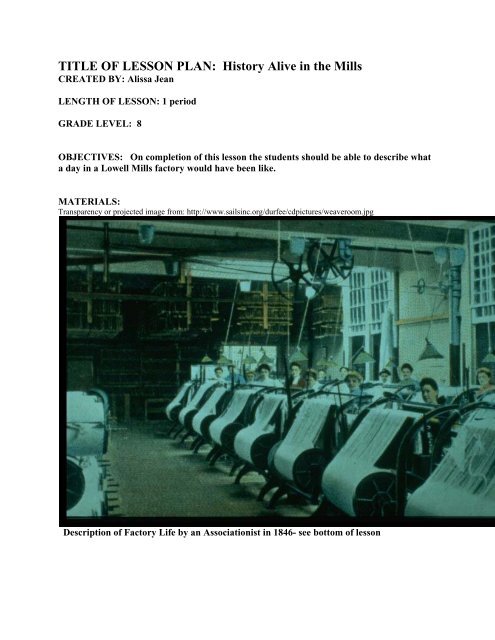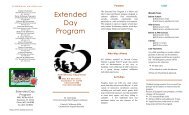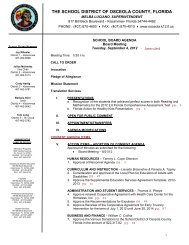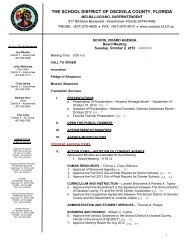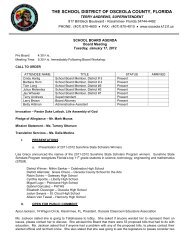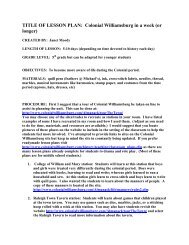TITLE OF LESSON PLAN: History Alive in the Mills
TITLE OF LESSON PLAN: History Alive in the Mills
TITLE OF LESSON PLAN: History Alive in the Mills
You also want an ePaper? Increase the reach of your titles
YUMPU automatically turns print PDFs into web optimized ePapers that Google loves.
<strong>TITLE</strong> <strong>OF</strong> <strong>LESSON</strong> <strong>PLAN</strong>: <strong>History</strong> <strong>Alive</strong> <strong>in</strong> <strong>the</strong> <strong>Mills</strong><br />
CREATED BY: Alissa Jean<br />
LENGTH <strong>OF</strong> <strong>LESSON</strong>: 1 period<br />
GRADE LEVEL: 8<br />
OBJECTIVES: On completion of this lesson <strong>the</strong> students should be able to describe what<br />
a day <strong>in</strong> a Lowell <strong>Mills</strong> factory would have been like.<br />
MATERIALS:<br />
Transparency or projected image from: http://www.sails<strong>in</strong>c.org/durfee/cdpictures/weaveroom.jpg<br />
Description of Factory Life by an Associationist <strong>in</strong> 1846- see bottom of lesson
PROCEDURE: Beg<strong>in</strong> by review<strong>in</strong>g with students <strong>the</strong> <strong>in</strong>formation <strong>the</strong>y ga<strong>in</strong>ed from <strong>the</strong>ir<br />
Duel<strong>in</strong>g Poems us<strong>in</strong>g a Venn diagram to compare and contrast mill life and farm life.<br />
Farm Life<br />
Factory Life<br />
Us<strong>in</strong>g <strong>the</strong> overhead projector or a pre-made transparency, I will project an image of<br />
factory workers from <strong>the</strong> resources list.<br />
While <strong>the</strong> image is projected I will ask <strong>the</strong> follow<strong>in</strong>g questions:<br />
Lower level:<br />
What do you see?<br />
What is happen<strong>in</strong>g?<br />
Higher level:<br />
What do you th<strong>in</strong>k will happen next?<br />
Students will piece toge<strong>the</strong>r <strong>the</strong> scenario with <strong>the</strong> answers to <strong>the</strong> questions.<br />
Students will <strong>the</strong>n be given 5 m<strong>in</strong>utes to make an identity for one of <strong>the</strong> people <strong>in</strong> <strong>the</strong><br />
picture. They should <strong>in</strong>clude:<br />
What is <strong>the</strong>ir name?<br />
Where did <strong>the</strong>y come from?<br />
What is <strong>the</strong> reason <strong>the</strong>y are work<strong>in</strong>g at <strong>the</strong> mill?<br />
What do <strong>the</strong>y hope to do <strong>in</strong> <strong>the</strong> future?<br />
What do <strong>the</strong>y like about work<strong>in</strong>g <strong>in</strong> <strong>the</strong> mill?<br />
What do <strong>the</strong>y dislike about work<strong>in</strong>g <strong>in</strong> <strong>the</strong> mill?<br />
They should write <strong>the</strong> answers down so <strong>the</strong> <strong>in</strong>formation is readily available.<br />
Students will <strong>the</strong>n step <strong>in</strong>to <strong>the</strong> picture and become statues. They are to rema<strong>in</strong> frozen<br />
until <strong>the</strong>y are tapped to come to life and <strong>the</strong> <strong>in</strong>structor will ask <strong>the</strong>m any of <strong>the</strong> previous<br />
questions.<br />
Hav<strong>in</strong>g factory noises play <strong>in</strong> <strong>the</strong> background helps to set <strong>the</strong> scene.<br />
When <strong>the</strong> students have successfully recreated history <strong>the</strong>y will go back to <strong>the</strong>ir seats for a<br />
debrief<strong>in</strong>g.<br />
What conclusions can we come to about life <strong>in</strong> <strong>the</strong> Lowell <strong>Mills</strong> from this picture?<br />
Students will be given <strong>the</strong> primary source handout: Description of Factory Life by an<br />
Associationist <strong>in</strong> 1846- see attached. They are to read <strong>the</strong> handout and fill out <strong>the</strong> graphic<br />
organizer<br />
EVALUATION: Students will be evaluated by <strong>the</strong>ir participation <strong>in</strong> br<strong>in</strong>g<strong>in</strong>g <strong>the</strong> picture<br />
to life and <strong>the</strong>ir graphic organizer.
EXTENSION (if any): Wrap up:<br />
Debrief<strong>in</strong>g<br />
1. What are some th<strong>in</strong>gs about factory life you were surprised by?<br />
2. Do you th<strong>in</strong>k you would have stayed on <strong>the</strong> farm or gone to work <strong>in</strong> <strong>the</strong> factory?<br />
3. What were some of <strong>the</strong> responsibilities of <strong>the</strong> mill workers?<br />
TAH GRANT REFERENCES: TAH grant lessons June 12-June 18, 2009 NEH Lowell<br />
workshop June 28- July 3, 2009<br />
STANDARDS: SS.B.1.3.6- The student understands <strong>the</strong> ways <strong>in</strong> which regional systems<br />
are <strong>in</strong>terconnected.<br />
SS.B.2.3.3- The students understands <strong>the</strong> ways cultures differ <strong>in</strong> <strong>the</strong>ir use of similar<br />
environments and resources.<br />
SS.B.1.3.4- The student understands ways factors such as culture and technology <strong>in</strong>fluence<br />
<strong>the</strong> perception of places and regions.<br />
Habits of <strong>the</strong> m<strong>in</strong>d: Change and cont<strong>in</strong>uity, Historical empathy
Description of Factory Life by Associations <strong>in</strong> 1846<br />
We have lately visited <strong>the</strong> cities of Lowell and Manchester, and have had an<br />
opportunity of exam<strong>in</strong><strong>in</strong>g <strong>the</strong> factory system more closely than before. We<br />
had distrusted <strong>the</strong> accounts, which we had heard from persons engaged <strong>in</strong><br />
<strong>the</strong> Labor Reform, now beg<strong>in</strong>n<strong>in</strong>g to agitate New England; we could scarcely<br />
credit <strong>the</strong> statements made <strong>in</strong> relation to <strong>the</strong> exhaust<strong>in</strong>g nature of <strong>the</strong> labor<br />
<strong>in</strong> <strong>the</strong> mills, and to <strong>the</strong> manner <strong>in</strong> which <strong>the</strong> young women, <strong>the</strong> operatives,<br />
lived <strong>in</strong> <strong>the</strong>ir board<strong>in</strong>g-houses, six sleep<strong>in</strong>g <strong>in</strong> a room, poorly ventilated.<br />
We went through many of <strong>the</strong> mills, talked particularly to a large number of<br />
<strong>the</strong> operatives, and ate at <strong>the</strong>ir board<strong>in</strong>g-houses, on purpose to ascerta<strong>in</strong> by<br />
personal <strong>in</strong>spection <strong>the</strong> facts of <strong>the</strong> case. We assure our readers that very<br />
little <strong>in</strong>formation is possessed, and no correct judgments formed, by <strong>the</strong><br />
public at large, of our factory system, which is <strong>the</strong> first germ of <strong>the</strong><br />
Industrial or Commercial Feudalism, that is to spread over our land.<br />
In Lowell live between seven and eight thousand young women, who are<br />
generally daughters of farmers of <strong>the</strong> different States of New England; some<br />
of <strong>the</strong>m are members of families that were rich <strong>the</strong> generation before.<br />
The operatives work thirteen hours a day <strong>in</strong> <strong>the</strong> summer time and from<br />
daylight to dark <strong>in</strong> <strong>the</strong> w<strong>in</strong>ter. At half past four <strong>in</strong> <strong>the</strong> morn<strong>in</strong>g <strong>the</strong> factory<br />
bell r<strong>in</strong>gs, and at five <strong>the</strong> girls must be <strong>in</strong> <strong>the</strong> mills. A clerk, placed as a<br />
watch, observes those who are a few m<strong>in</strong>utes beh<strong>in</strong>d <strong>the</strong> time, and effectual<br />
means are taken to stimulate to punctuality. This is <strong>the</strong> morn<strong>in</strong>g<br />
commencement of <strong>the</strong> <strong>in</strong>dustrial discipl<strong>in</strong>e- (should we not ra<strong>the</strong>r say<br />
<strong>in</strong>dustrial tyranny?) which is established <strong>in</strong> <strong>the</strong>se Associations of this m oral<br />
and Christian community. At seven <strong>the</strong> girls are allowed thirty m<strong>in</strong>utes for<br />
breakfast, and at noon thirty m<strong>in</strong>utes more for d<strong>in</strong>ner, except dur<strong>in</strong>g <strong>the</strong><br />
first quarter of <strong>the</strong> year, when <strong>the</strong> time is extended to forty-five m<strong>in</strong>utes.<br />
But with<strong>in</strong> this time <strong>the</strong>y must hurry to <strong>the</strong>ir board<strong>in</strong>g-houses and return to<br />
<strong>the</strong> factory and that through <strong>the</strong> hot sun, or <strong>the</strong> ra<strong>in</strong> and cold. A meal eaten<br />
under such circumstances must be quite unfavorable to digestion and health,<br />
as any medical man will <strong>in</strong>form us. At seven o'clock <strong>in</strong> <strong>the</strong> even<strong>in</strong>g <strong>the</strong><br />
factory bell sounds <strong>the</strong> close of <strong>the</strong> days work.<br />
Thus thirteen hours per day of close attention and monotonous labor are<br />
exacted from <strong>the</strong> young women <strong>in</strong> <strong>the</strong>se manufactories. . . So fatigued-we<br />
should say, exhausted and worn out but we wish to speak of <strong>the</strong> system <strong>in</strong><br />
<strong>the</strong> simplest language-are numbers o f <strong>the</strong> girls, that <strong>the</strong>y go to bed soon<br />
after <strong>the</strong>ir even<strong>in</strong>g meal? and endeavor by a comparatively long sleep to<br />
resuscitate <strong>the</strong>ir weakened frames for <strong>the</strong> toils of <strong>the</strong> com<strong>in</strong>g day. When
Capital has got thirteen hours of labor daily out of a be<strong>in</strong>g, it can get noth<strong>in</strong>g<br />
more. It could be a poor speculation <strong>in</strong> an <strong>in</strong>dustrial po<strong>in</strong>t of view to own <strong>the</strong><br />
operative; for <strong>the</strong> trouble and expense of provid<strong>in</strong>g for times of sickness and<br />
old age could more than counterbalance <strong>the</strong> difference between <strong>the</strong> price of<br />
wages and <strong>the</strong> e expense of board and cloth<strong>in</strong>g. The far greater number of<br />
fortunes, accumulated by <strong>the</strong> North <strong>in</strong> comparison with <strong>the</strong> South, shows<br />
that hirel<strong>in</strong>g labor is more profitable for Capital than slave labor.<br />
Now let us exam<strong>in</strong>e <strong>the</strong> nature of <strong>the</strong> labor itself, and <strong>the</strong> conditions under<br />
which it is performed. Enter with us <strong>in</strong>to <strong>the</strong> large rooms, when <strong>the</strong> looms<br />
are at work. The largest that we saw is <strong>in</strong> <strong>the</strong> Amoskeag <strong>Mills</strong> at Manchester.<br />
It is four hundred feet long, and about seventy broad; <strong>the</strong>re are five<br />
hundred looms, and twenty-one thousand sp<strong>in</strong>dles <strong>in</strong> it. The d<strong>in</strong> and clatter<br />
of <strong>the</strong>se five hundred looms under full operation, struck us on first enter<strong>in</strong>g<br />
as someth<strong>in</strong>g frightful and <strong>in</strong>fernal, for it seemed such a n atrocious violation<br />
of one of <strong>the</strong> faculties of <strong>the</strong> human soul, <strong>the</strong> sense of hear<strong>in</strong>g. After a while<br />
we became somewhat <strong>in</strong>ured to it, and by speak<strong>in</strong>g quite close to <strong>the</strong> ear of<br />
an operative and quite loud, we could hold a conversation, and make <strong>the</strong><br />
<strong>in</strong>quiri es we wished.<br />
The girls attend upon an average three looms; many attend four, but this<br />
requires a very active person, and <strong>the</strong> most unremitt<strong>in</strong>g care. However, a<br />
great many do it. Attention to two is as much as should be demanded of an<br />
operative. This gives us some id ea of <strong>the</strong> application required dur<strong>in</strong>g <strong>the</strong><br />
thirteen hours of daily laborer. The atmosphere of such a room cannot of<br />
course be pure; on <strong>the</strong> contrary it is charged<br />
with cotton filaments and dust, which, we were told, are very <strong>in</strong>jurious to<br />
<strong>the</strong> lungs.
Use this paper to complete <strong>the</strong> factory scene. Then as you read: Description<br />
of Factory Life by an Associationist <strong>in</strong> 1846 write down any surpris<strong>in</strong>g details<br />
about factory life.


